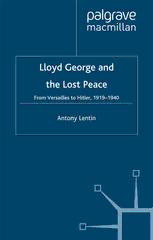Table Of ContentLloyd George and the Lost Peace
Lloyd George at the Paris Peace Conference, 1919 (William Orpen):
‘Mr Lloyd George . . . sat, his face lit with that smile, so quick and sunny, yet so obscure . . .
his whole air, at once so alert and self-poised, full of a baffling fascination and disquiet.’
— A. G. Gardiner
Lloyd George and
the Lost Peace
From Versailles to Hitler, 1919–1940
Antony Lentin
Professor of History
The Open University
© Antony Lentin 2001
Softcover reprint of the hardcover 1st edition 2001 978-0-333-91961-3
All rights reserved. No reproduction, copy or transmission of
this publication may be made without written permission.
No paragraph of this publication may be reproduced, copied or
transmitted save with written permission or in accordance with
the provisions of the Copyright, Designs and Patents Act 1988,
or under the terms of any licence permitting limited copying
issued by the Copyright Licensing Agency, 90 Tottenham Court
Road, London W1P 0LP.
Any person who does any unauthorised act in relation to this
publication may be liable to criminal prosecution and civil
claims for damages.
The author has asserted his right to be identified
as the author of this work in accordance with the
Copyright, Designs and Patents Act 1988.
First published 2001 by
PALGRAVE
Houndmills, Basingstoke, Hampshire RG21 6XS and
175 Fifth Avenue, New York, N. Y. 10010
Companies and representatives throughout the world
PALGRAVE is the new global academic imprint of
St. Martin’s Press LLC Scholarly and Reference Division and
Palgrave Publishers Ltd (formerly Macmillan Press Ltd).
ISBN 978-1-349-42407-8 ISBN 978-0-230-51148-4 (eBook)
DOI 10.1057/9780230511484
This book is printed on paper suitable for recycling and
made from fully managed and sustained forest sources.
A catalogue record for this book is available
from the British Library.
Library of Congress Cataloging-in-Publication Data
Lentin, A. (Antony)
Lloyd George and the lost peace : from Versailles to Hitler,
1919–1940 / Antony Lentin.
p. cm.
Includes bibliographical references and index.
ISBN 978-1-349-42407-8 (clo
th)
1. Lloyd George, David, 1863–1945—Views on foreign relations.
2. Great Britain—Foreign relations—1910–1936. 3. Great Britain–
–Foreign relations—1936–1945. 4. World War, 1939–1945–
–Causes. 5. Treaty of Versailles (1919) I. Title.
DA566.9.L5 L45 2001
941.083’092—dc21
2001021260
10 9 8 7 6 5 4 3 2 1
10 09 08 07 06 05 04 03 02 01
To Michael Duffy, Barrister-at-Law
Vir bonus, peritus dicendi
This page intentionally left blank
Contents
List of Illustrations viii
Acknowledgements ix
Preface x
Introduction xiv
1 Enigma Variations:Lloyd George at the Paris
Peace Conference, 1919 1
2 Reparations and Reputations:Lloyd
George and Lord Cunliffe 23
3 The Treaty that Never Was:Lloyd George
and the French Connection, 1919 47
4 The Worm in the Bud:`Appeasement'
at the Peace Conference 67
5 The Magic Mountain:Lloyd George and
Hitler at the Berghof, 1936 89
6 `A Conference Now':Lloyd George,
Chamberlain and Churchill, 1939±40 106
Notes 129
Bibliography 163
Index 172
vii
List of Illustrations
Lloyd George at the Paris Peace Conference, 1919 (William
Orpen; courtesy National Museums and Galleries of Wales)
frontispiece
2.1 Lord Cunliffe as Governor of the Bank of England
(Francis Dodd, 1932; courtesy the Bank of England) 25
4.1 The Treaty of Versailles is delivered to the Palace of Versailles
by the Secretary-General of the Peace Conference,
Paul Dutasta, 28 June 1919 78
5.1 Hitler welcomes Lloyd George to the Berghof,
Berchtesgaden, 4 September 1936 (photo:Kurt Huhle,
courtesy the National Library of Wales) 95
Every effort has been made to contact the copyright holders for the
illustrations. If anyone has been overlooked, the publishers will be
pleased to make the necessary arrangements at the first opportunity.
viii
Acknowledgements
For permission to consult and quote from unpublished material, my
thanks are due to: the British Library (Balfour Papers); the Clerk of the
Records, the House of Lords Record Office, on behalf of the Beaverbrook
Foundation Trust (Bonar Law and Lloyd George Papers); (the British
Library and Professor A.K.S. Lambton (Robert Cecil Papers); the Bank
of England Archives (Cunliffe and Montagu Norman Papers); Lord Cun-
liffe (the first Lord Cunliffe's letters to his wife); the Clerk of the Records,
the House of Lords Record Office ( J.C. Davidson Papers); Lambeth
Palace Library (Randall Davidson Papers and George Bell Papers); Lord
Derby and the British Library (letter from 17th Earl of Derby to A.J.
Balfour); the Bodleian Library, Oxford (H.A.L. Fisher Papers); the
Churchill Archives Centre, Churchill College, Cambridge (Hankey
Papers); the Syndics of Cambridge University Library (Hardinge Papers);
the Provost and Scholars of King's College, Cambridge (Keynes Papers);
the Scottish Record Office, Edinburgh, and the Marquess of Lothian
(Lothian Papers); the Bodleian Library and the Warden and Fellows of
New College, Oxford (Milner Papers); Trinity College, Cambridge
(Edwin Montagu Papers); the National Library of Wales, Aberystwyth
(A.J. Sylvester Papers); the Public Record Office, Kew, Archives du Min-
isteÁre des Affaires EtrangeÁres, Paris, and Service historique de l'ArmeÂede
Terre, Vincennes. I also wish to thank Mr Magnus John; Dr Barbara
Slater; the Open University for grants in aid; and the President and
Fellows of Wolfson College, Cambridge, for a further agreeable year as
a Visiting Fellow.
ix

